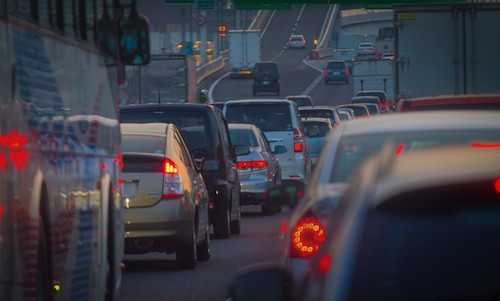Complex systems around us
Occurrence of natural traffic congestion
Why does natural traffic congestion occur?
When traveling on an expressway in heavy traffic, patches of congestion occur frequently despite the lack of an obvious cause such as roadworks or accidents, and this congestion disappears as quickly as it comes. This kind of traffic jam, which occurs without any obvious cause, is termed “natural traffic congestion” by Japanese researchers . Why does this natural traffic congestion occur?

There are some clues. Although vehicles are less than one meter apart when waiting at a traffic light, this space can be 20 or 30 meters when driving. (Professor Katsuhiro Nishinari, a proponent of traffic congestion studies, suggests that an intra-vehicle distance of 40 meters on expressways makes congestion less likely to occur.) In addition, when a traffic light turns green and the vehicle ahead sets off, your own vehicle does not usually follow immediately, but after a lag of one or two seconds.
Locations where natural traffic congestion tends to occur include sag curves (i.e. the beginning of long, gentle uphill sections) and entrances to tunnels. When approaching sag curves or tunnel entrances, even though drivers intend to maintain their speed, there is a natural tendency for it to decline. This results in the distance to the following vehicle shrinking, which causes the vehicle behind to hit the brakes momentarily. The vehicle behind that brakes because the vehicle in front of it has braked, and the vehicle behind that vehicle breaks in the same way so that, if there are a certain number of vehicles involved, they come to a stop.
In other words, when the intra-vehicle distance is too short, slight variations in vehicle speed occur at SAG curves, etc., leading to the following vehicles behind braking in succession and amplifying the initial “slight variation.”

If the drivers were able to make judgments and act instantaneously, like machines, it is likely that all the vehicles would decelerate at once, before all returning to the original speed at the next stage. However, because the drivers are human there is a time lag before they react, which leads to the phenomenon described above.
When congestion occurs, it results in an extreme reduction in the flow rate of the highway, so the degree to which the occurrence of congestion can be avoided is a key issue.
Reproducing natural traffic congestion through simulations
The natural traffic congestion occurrence model we present here reproduces the natural traffic congestion mechanism in the form of a multi-agent simulation model. It represents 22 vehicles distributed and driving around a circular test course with a radius of 37m.(⇒Reference to natural traffic congestion occurrence model)
artisoc or artisoc player (free) is required to execute this model.
For some time after the simulation starts, the fluctuations in speed are extremely small, so the vehicles are able to drive without congestion. Variations in intra-vehicle distance appear gradually, and after approximately 10 minutes have elapsed, congestion suddenly occurs.
Once congestion has occurred, it will continue to exist until some kind of external manipulation is performed, such as reducing the number of vehicles on the course. Also, and interestingly, the location of the congestion shifts little by little. This phenomenon occurs in real life. For example, after an accident or something of that kind has caused congestion, a little while after the site of the accident becomes passable, the congestion moves to a location a considerable distance behind the accident site. It has been confirmed that the kind of congestion that occurs within the natural traffic congestion occurrence model also occurs in experiments using real vehicles. The video below shows an experiment conducted by Professor Nishinari of the University of Tokyo.
How can we control the occurrence of natural traffic congestion?
Natural traffic congestion occurs more easily when vehicle densities are high and distances between vehicles are short. Using the natural traffic congestion occurrence model, we measured the relationship between vehicle density and traffic flow rates, the results of which are shown in the graph below. The horizontal axis shows the number of vehicles on the test course (vehicle density), and the vertical axis shows the number of vehicles passing the measurement point every 10 minutes (traffic flow rate).
When vehicle densities are low, the flow rate tends to increase monotonically in accordance with the increase in the number of vehicles, but when a certain level of density is reached, cases in which the flow rate falls dramatically begin to appear. These are the kind of cases in which congestion occurs. In addition, for densities between approximately 0.12 and 0.15, states with extremely high flow rates and low flow rates occur even at the same level of density, and we find that there is considerable variation in the results.
At such times, the high flow rate state is extremely unstable, and collapses into a low flow rate immediately on the occurrence of an event such as brakes being pressed. Such unstable circumstances are known as “metastable states.”
In order to control the occurrence of natural traffic congestion, it is necessary to avoid situations in which the distance between vehicles shortens and lengthens due to fluctuations in human behavior when vehicle densities are high. Human beings each have their own will, and when they are in a hurry, they are quick to reduce this distance, which is behavior that cannot be controlled coercively.
Let's try setting the fluctuation in the speed within the natural traffic congestion occurrence model to 0km/h and see what happens when we execute it. When we do this, from the time the simulation begins, there is no change in the intra-vehicle distance, and congestion never occurs. If completely centralized controllability of vehicles becomes common in a future society, it may be that congestion will occur only rarely, even in situations where traffic densities are high, and that high traffic flow rates can be maintained.
University of Tokyo Professor Nishinari conducted a social experiment near the Kobotoke Tunnel on the Chuo Expressway, which is a well-known blackspot for traffic congestion. In this experiment, eight vehicles were sent through the Kobotoke Tunnel, all maintaining the same distance between each other, at times of congestion. The result was that by the time the eight vehicles had completed their passage through the tunnel, the average speed had recovered to 80 km/h.
In this way it is possible to mitigate the effects of congestion by adroitly inducing certain behaviors in people. If you have some ideas of your own, why not try them out to see if they work well in a simulation?




